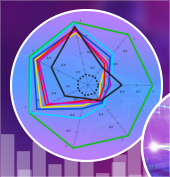
Parkinson’s disease is the most common neurological movement disorder, with a prevalence of up to 2% in the elderly. The new research published in this Special issue represents the edge between the current technical abilities of engineering solutions and clinical applications for the management of Parkinson’s disease, spanning wearable technologies and the Internet of Things, body sensor networks and smart home techniques.
Clinical assessments throughout the course of Parkinson’s disease consume substantial resources and repeated assessments are generally impractical. Most techniques only provide a snap-shot of the patients’ daily life impairments rather than the progression of the disease and efficacy of treatment. From a clinical perspective, sensor-based movement diagnostics offers significant benefits. Sensor-based diagnostics can be conducted remotely in free-living environments, thus improving assessment quality and allowing continuous quantitative assessment. The ability to continuously analyse motor movements during everyday living creates the potential for unobtrusive assessment and monitoring under real-life conditions. This objective information on quality of life and daily functioning could complement the diagnostic workup to greatly enhance disease management and address individual patients’ needs – while ultimately reducing healthcare costs.
This special issue introduces a number of important new ideas and technologies, including the application of body sensor networks to aid diagnosis, monitoring and treatment for a wide variety of chronic neurologic and musculoskeletal disorders:
The articles included in this Special Issue are:
- Body Sensor Network-based Kinematic Characterization and Comparative Outlook of UPDRS Scoring in Leg Agility, Sit-to-Stand, and Gait Tasks in Parkinson’s Disease
Authors: Parisi, Federico; Ferrari, Gianluigi; Giuberti, Matteo; Contin, Laura; Cimolin, Veronica; Azzaro, Corrado; Albani, Giovanni; Mauro, Alessandro - Classification of Parkinson’s Disease Gait Using Spatial-Temporal Gait Features
Authors: Wahid, Ferdous; Begg, Rezaul; Hass, Chris; Halgamuge, Saman; Ackland, David - Contribution of a Trunk Accelerometer System to the Characterization of Gait in Patients with Mild to Moderate Parkinson’s disease
Authors: Demonceau, Marie; Donneau, Anne-Françoise; Croisier, Jean-Louis; Skawiniak, Eva; Boutaayamou, Mohamed; Maquet, Didier; Garraux, Gaëtan - A System for Real-Time Feedback to Improve Gait and Posture in Parkinson’s Disease
Authors: Jellish, Jeremy; Abbas, James; Ingalls, Todd; Mahant, Padma; Samanta, Johan; Ospina, Maria; Krishnamurthi, Narayanan - Characterization Methods for the Detection of Multiple Voice Disorders: Neurological, Functional, and Organic Diseases
Authors: Orozco-Arroyave, Juan; Belalcázar-Bolaños, Elkyn; Arias-Londoño, Julián; Vargas-Bonilla, Jesús; Skodda, Sabine; Rusz, Jan; Hönig, Florian; Daqrouq, Khaled; Nöth, Elmar - Validity and responsiveness of at-home touch-screen assessments in advanced Parkinson’s disease
Authors: Memedi, Mevludin; Nyholm, Dag; Johansson, Anders; Pålhagen, Sven; Willows, Thomas; Widner, Håkan; Linder, Jan; Westin, Jerker - A Smartphone-based Tool for Assessing Parkinsonian Hand Tremor
Authors: Kostikis, Nikolaos; Hristu-Varsakelis, Dimitrios; Arnaoutoglou, Marianthi; Kotsavasiloglou, Christos - Prediction of Freezing of Gait in Parkinson’s from Physiological Wearables: An Exploratory Study
Authors: Mazilu, Sinziana; Calatroni, Alberto; Gazit, Eran; Mirelman, Anat; Hausdorff, Jeffrey; Troester, Gerhard - Dual Motor-Cognitive Virtual Reality Training Impacts Dual-Task Performance in Freezing of Gait
Authors: Killane, Isabelle; Fearon, Conor; Newman, Louise; McDonnell, Conor; Waechter, Saskia; Sons, Kristian; Lynch, Timothy; Reilly, Richard - What Engineering Technology Could Do for Quality of Life in Parkinson’s Disease: a Review of Current Needs and Opportunities
Authors: Stamford, Jon; Schmidt, Peter; Friedl, Karl - An Emerging Era in the Management of Parkinson’s disease: Wearable Technologies and the Internet of Things
Authors: Pasluosta, Cristian; Gassner, Heiko; Winkler, Juergen; Klucken, Jochen; Eskofier, Bjoern - Analyzing Activity Behavior and Movement in a Naturalistic Environment using Smart Home Techniques
Authors: Cook, Diane; Dawadi, Prafulla; Schmitter-Edgecombe, Maureen

